Best of Things, Components, Mountain-Bikes -
The 6 Best Mountain Bikes Pedals in 2020
Looking to buy a new mountain bike pedal?
You’re on the right page.
When it comes to pedals, it’s often one of the most overlooked components on the mountain bike. Most times, things such as tires, saddles, drivetrain and even suspension systems get more attention.
The pedal is one of the 3 important contact points between you and your mountain bike (the other 2 being saddle and handlebar grips).
So a good and durable set of pedals are equally important.
Let's take a look at 6 of the best mountain bike pedals today.
Best Clipless Mountain Bike Pedals
1. Shimano XTR M9100
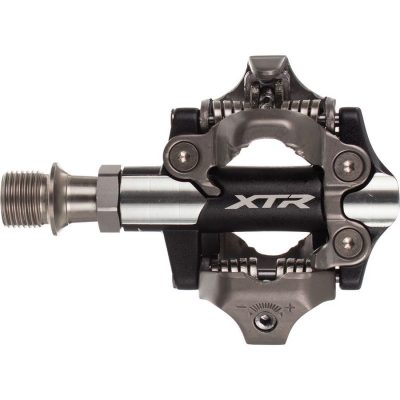
Be it road bike or mountain bike, Shimano has traditionally set the bar for value with its pedals. The XTR M9100 pedal is no exception.
With its forged alloy body and chromoly spindle, this pedal is one of the best when it comes to resisting wear and tear. Tension settings for entry and release are easily adjustable via a screw on the top of each pedal. The Shimano XTR pedal has been updated from its predecessor to improve on its mud shedding capabilities and to provide more stability with a wider contact patch.
This is Shimano’s top of the line mountain bike pedals and you’d be sure to get excellent durability and quality Shimano craftsmanship.
2. CrankBrothers Egg Beater 3
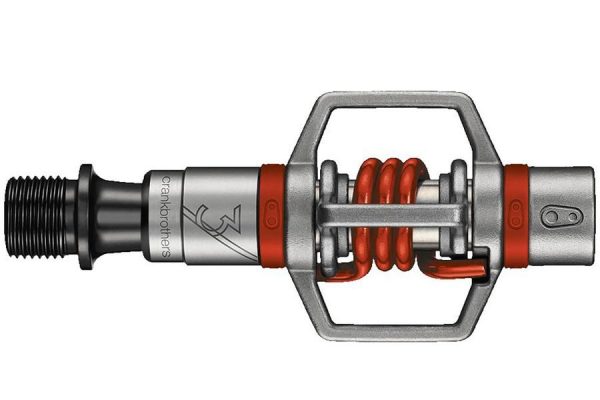
If you’re looking to get started with clipless mountain bike pedals and on a budget, it’s tough to beat the Egg Beater 3 from CrankBrothers.
Clipping into the Egg Beater 3 is a breeze with its 4 sided entry. This pedal sheds mud easily with a minimalist design that offers few nooks and crannies for debris to collect. Low profile also means low weight; the Egg Beater 3 weighs in at just 280g per pair.
A stainless steel body, wings and spring and a steel spindle offer excellent durability. Float angle is adjustable with release angle options from 15 degrees to 20 degrees. Brass cleats are included.
3. Speedplay SYZR
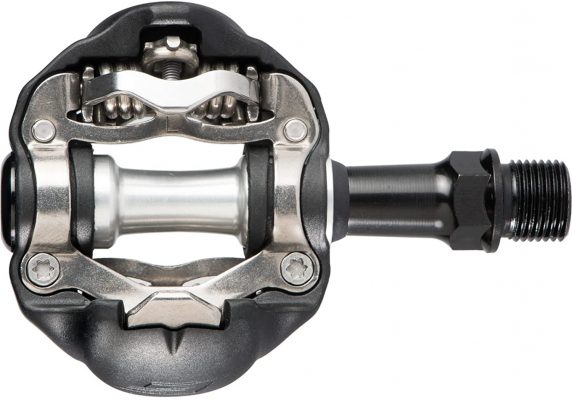
Speedplay is well-known for its pedals adjustability and the SYZR is no exception.
The SYZR pedals are available in 5 different spindle lengths and with a micro-adjustable float, allowing for a 10-degree range of float.
Speedplay also touts its Direct Drive technology with the SYZR, which the company says maximizes efficiency with power transfer through the cleat as opposed to through the rubber sole of your cycling shoe.
Four points of contact between cleat and pedal ensure a tight cleat to pedal fit, eliminating loss from a loose connection. While these performance features may make this an attractive pedal set, they don’t come cheap.
The Speedplay SYZR is one of the most expensive pedal sets you can buy.
Best Flat Mountain Bike Pedas
1. RaceFace Chester
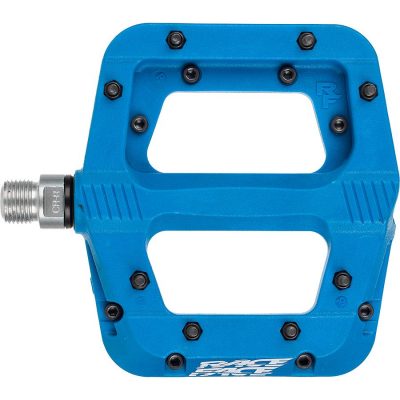
Flat pedals have gained more and more of a following in recent years due largely to the convenience and versatility they offer. With demand rising, companies such as RaceFace are looking for ways to improve on old technology.
The Chester does this by cutting weight and bulk. A nylon composite pedal and chromoly steel spindle gives this platform pedal a relatively light weight at 340g. Eight traction pins help to keep your shoe from sliding off while the highly durable plastic pedal does a nice job of absorbing shock.
At a rock bottom price point, the Chester is a great option for those looking for quality at a budget price.
2. Crankbrothers Stamp 7
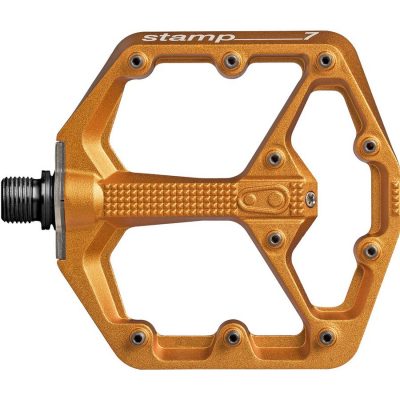
Crankbrothers, well known for its line of clipless mountain bike pedals, also has one of the top platform pedals you can buy for your rig.
The Stamp 7 comes in two sizes, small and large. The small version, recommended for shoe sizes from 5-10 (US), features a large platform at 100x100mm and a low profile at just 13 mm thick. It’s made out of forged aluminum with a chromoly steel spindle and 10 adjustable grip pins per side.
The large, recommended for shoe sizes (10-15) takes that up a notch with 114-111mm platform at about the same thickness.
Both pedal sizes are slightly concave to help hold your foot in place. The solid construction, innovative design and affordable price tag of the Stamp 7 make it an excellent value for a platform pedal.
3. Shimano PD-M8040
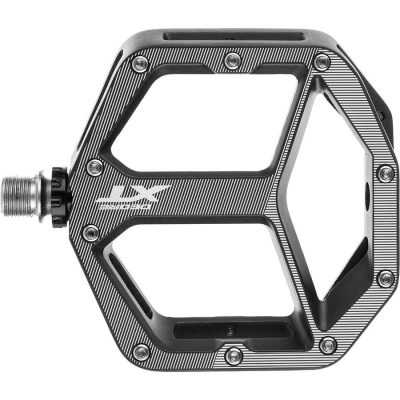
You knew flat pedals were more than just a passing trend among mountain bikers when
Shimano, one of the most highly regarded pedal and component manufacturers out there, announced its own flat-pedal offering with the launch of the PD-M8040, the best quality flat pedal available on the market.
The M8040’s come in two platform options to suit different shoe sizes. The pedal features a hollowed aluminum body with plenty of large holes for mud shedding and rounded off corners for bouncing off obstacles.
At 18mm thick, these aren’t the thinnest pedals on the market; however, they are slightly concave to allow your foot to sink into them. Each platform is outfitted with 10 screw-in pins for traction.
Types of Mountain Bike Pedals
You might not notice it yet, but did you know that there are 5 types of mountain bike pedals out there today?
The obvious ones are flat pedals and Shimano SPD pedals, which most of us know about. But there are also others such as Crankbrothers, Speedplay and Time.
Let’s take a closer look at the 5 different types of mountain bike pedals.
1. Flat Pedals
Flat pedals are your standard non clip-in pedals that anyone who has ever ridden a bike is familiar with. These are low-performance old technology, right?
Wrong.
Increased demands on flat pedals have led to innovations in flat pedal design. Over the years, manufacturers have made them lighter, thinner and grippier with screw-in pins on the platform such as those found on Shimano M8040 and Crankbrothers Stamp 7 pedals.
2. Shimano SPD
Shimano’s pedal system uses two-bolt cleats that are significantly smaller than their road bike pedals, which allows shoe manufacturers to surround them with tread, allowing for much easier walking in these shoes when not on the bike.
The cleats are also made out of steel, meaning they last significantly longer than the plastic cleats you find on road bikes.
Shimano SPD pedals are double-sided, making entry into the pedals easier than one-sided options. This is a huge factor. No one wants to be searching for their clips while heading into a particularly technical stretch of single track.
One fine example is the XTR M9100, which is Shimano’s top of the line mountain bike pedals.
3. Crankbrothers
Crankbrothers is best known for its egg beater clipless pedal, which offers four points of entry and a very low profile pedal that resembles, well, an egg beater. But in recent years it has also developed other styles including the Mallet, which is similar in appearance and functionality to Shimano’s SPD, the Candy, which offers a larger platform than the eggbeater, and the Double Shot, a hybrid that works as both a clipless pedal and flat pedal.
4. Speedplay SYZR
Speedplay pedals are renowned for its fit, feel and user-friendly ergonomic features. It’s mountain bike range, the SYZR pedals are no exception.
Its unique style of its cleats, various spindle length and micro-adjustable float angles makes it attractive for those who are looking for full control over their bike fit and efficient power transfer.
5. Time ATAC
Time’s mountain bike clipless pedal system is designed with fit in mind.
The ATAC acronym stands for Auto Tension Adjustment Concept. So, what’s the concept?
Time’s system is designed to optimize float, rotation and cleat retention while maximizing power transfer. Time also allows you to adjust the release angle on the pedals through two cleat options. Release angle refers to how far you have to turn your shoe to release from the pedal.
Time’s Easy Cleat features a step-out angle of 10 degrees, made for touring cyclists and beginners. Time’s standard reversible cleat allows for a release angle of 13 degrees or 17 degrees.
What to Look for In A Mountain Bike Pedal
Pedals often get short shrift when it comes to mountain biking. Suspension, frame weight, wheels and drivetrain get much more attention.
Pedals are usually an afterthought.
This shouldn’t be the case.
Pedals have a huge impact on how the bike fits you as well as bike safety. A poorly selected pedal can do damage to your knees and hips or worse if you struggle to clip out of them, or you clip out of them too easily.
How do you choose the right pedal?
Let’s take a closer look at the 6 things you should know about mountain bike pedals.
1. Pedal Float
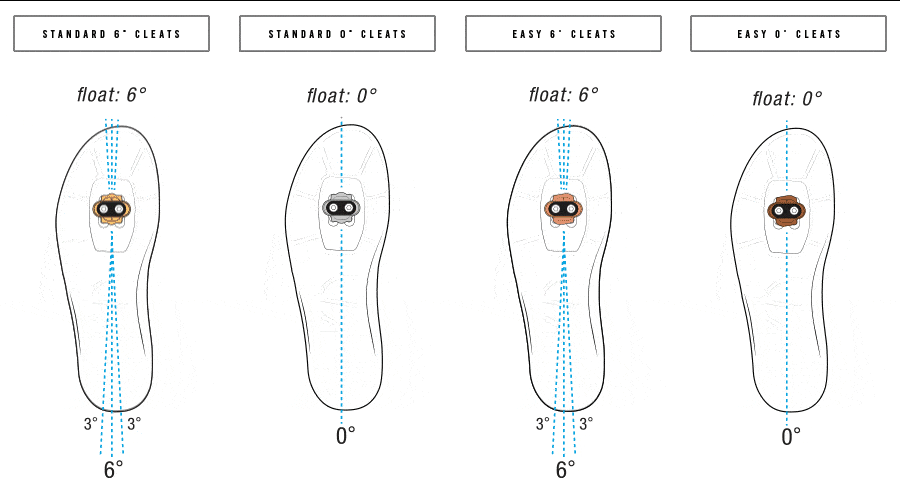
Float refers to how much your foot can move on the pedal while clipped in. It’s measured in float angle.
A small float angle between 0 and 6 degrees will allow your foot very little movement before clipping out. While this makes clipping out easier, it also means that you’re more likely to come out of the pedals when you don’t want to.
A higher float angle, from 6 to 15 degrees, allows your foot to easily turn while remaining clipped in, which is useful when making aggressive turns. However, a higher angle makes it more difficult to unclip, which may make less-experienced riders feel unsafe.
2. Platform Size
Mountain bike riders often have the misperception that platform size affects performance. This is in part because platform size does impact power transfer on road bikes.
But unless you’re riding flat pedals, that’s often not the case with clipless mountain biking pedals. Because the cleats on mountain bikes are considerably smaller to allow for the rugged tread on mountain bike shoes, platform size has little impact on performance with clipless pedals.
Even pedals that appear to have a large platform don’t offer more contact as the shoe often hovers above the pedal, only making physical contact with the cleat.
However, if you’re riding a clipless platform pedal, platform size can make all the difference as it offers more stability and better foot-to-pedal contact.
This is apparent in the huge platforms offered on such flat pedal sets as Shimano’s PD-M8040 and Crankbrothers’ Stamp 7.
3. Ease of Entry and Exit
It goes without saying that your ability to get in and out of a clipless pedal quickly is crucial.
You want a pedal that you don’t have to fumble with as you accelerate into a difficult section of single track.
Getting out of your pedal is even more important. Your ability to unclip quickly can be the difference between being able to correct yourself with a quick foot to the ground and crashing painfully to your side on roots and rocks.
With that in mind, consider pedal sets that offers multiple points of entry for easy clipping-in such as the Crankbrothers Eggbeater 3.
4. Release Tension Adjustability
Being able to adjust the release tension on your mountain bike pedals is critical.
Failure to get out of pedals that are too tight will quickly lead to injury. Likewise, unintentionally clipping out of pedals during aggressive rides can also lead to injury.
Imagine pedaling hard through a technical turn only to have your foot suddenly pull free of the pedal. It doesn’t take many hard landings to learn just how important release tension is.
Pedal such as Shimano’s XTR M9100 give you the ability to fine tune release tension to suit your riding abilities.
5. Mud Shedding Ability
There’s nothing worse than not being able to clip into your clipless pedals because their clogged with mud, tiny stones and twigs.
Look for pedals that are designed to prevent this problem.
Pedals such as the CrankBrothers Eggbeaters are designed to shed mud and other debris mid ride, preventing you from having to pull over and clean debris from your pedals.
6. Durability
Any component a mountain bike is inevitably going to take a beating, and the pedals get it worse than most.
Expect your pedals to be in the line of fire for all kinds of obstacles including roots, trees, rocks and anything else you might knock into as you head down the trail.
Flat pedals such as Shimano’s PD-M8040 are designed to deflect blows from obstacles. There’s also the clipping and clipping out process.
Unlike most road bike clipless pedal systems that feature plastic cleats, most mountain bike pedal systems feature metal cleats.
While these cleats are generally more durable, they can and will chew up the pedals each time you clip in and clip out. Manufacturers such as Shimano are known for designing pedals that are made out of durable materials that resist wear and tear.
The post The 6 Best Mountain Bikes Pedals in 2020 appeared first on The Geeky Cyclist.
